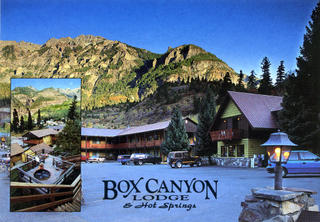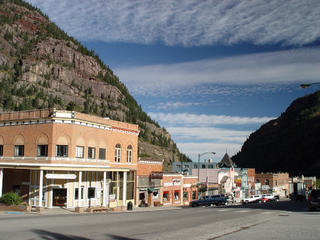Thursday, October 13, 2005
The Million Dollar Highway
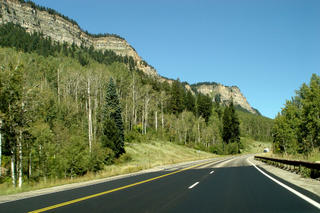 The day is cool, very clear, with no clouds. We head east for Durango on Highway 160. There are tall mountains in front of us, covered in pine. They look dark, backlit by the morning sun. We drive toward them through hilly, treed plains with blond pastures and green farmland where cows and horses graze, a land of lush trees and streams.
The day is cool, very clear, with no clouds. We head east for Durango on Highway 160. There are tall mountains in front of us, covered in pine. They look dark, backlit by the morning sun. We drive toward them through hilly, treed plains with blond pastures and green farmland where cows and horses graze, a land of lush trees and streams.We pass through Mancos and rise up into the mountains, with green valleys and farms in view down below. The mountains are covered with tall pines and other trees. Green grass has replaced
 desert scrub. Cows graze in mountain pastures.
desert scrub. Cows graze in mountain pastures.There are rows of blue hazy mountains in the east as we go by Hesperus and drive down into a valley. The valleys and mountains continue, pine-covered, rocky and narrow.
We come to Durango, a pretty town with the sparkling La Plata River running through it. We eat breakfast at Le Rendezvous, a great gourmet restaurant and bakery in the historic district. I had French toast made out of a sliced baguette, with blueberries. Two divorced high-maintenance broads sat near us, talking about their bad husbands, work and kids! Afterwards, we walked around town and bought an aspen leaf
 picture in a very nice high-end art and furniture shop.
picture in a very nice high-end art and furniture shop.After breakfast, we drive north on Highway 550, the Million Dollar Highway. There are two theories about this name. One is that it cost a million dollars to make the road; the other is that a woman said she wouldn’t go back there again for a million dollars! Personally, I think it is spectacular.
We travel through rounded pine-covered mountains, thickly banded with dark red and white rock. A white glider flies through the valley, landing at a small roadside airport. We pass through Honeyville, set up as an old-timey railroad town, complete with train and large tan-painted wood water tower for the train. A large herd of cattle graze nearby.
We drive halfway up the west side of a larger valley. In this valley there are long, narrow, lumpy, rocky ridges running along through the middle. These dark ridges are topped with expensive, million dollar houses. It is an oddly unique
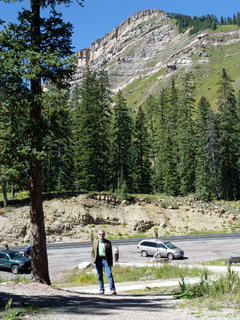 landscape, but very beautiful.
landscape, but very beautiful.We go up higher now into splendid, pointed mountains with tall, skinny pines and aspen. We take pictures at Coal Bank Pass and before Lime Creek Burn. We cross the Molas Divide and head down out of the mountains into Silverton, a small, pretty Victorian town in a flat valley.
Then we head up through higher mountain valleys again. We have seen hillsides of pine poles laid down flat, probably from avalanches. Between the pines there are open patches of brown, rust and deep yellow gravel on the mountainsides. There are no guardrails on the sides of steep drop-offs. Sneeze once driving a Mini Cooper and you’re done for!
In the Red Mountain area, old wooden mine shafts appear. There is one large one in particular halfway up the mountain, with old mine tailings running down into the river. We see some fall color on the hills, yellow aspens with the
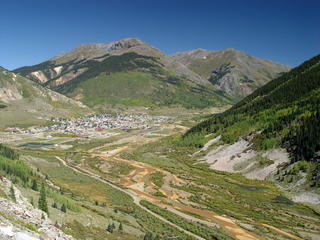 pine. We stop in the valley to take pictures. There is a high railroad trestle for loading ore, and some white clapboard houses, probably for the workers or mine company officials.
pine. We stop in the valley to take pictures. There is a high railroad trestle for loading ore, and some white clapboard houses, probably for the workers or mine company officials.We continue north on 550. A little way past the mines a bright yellow river runs next to the road! The surrounding rocks are also dyed yellow, possibly pollution from the mines? Part of a snowdrift still lies in the riverbed!
As we drive on, the mountains become solid gray, bare rock with sheer drop-offs and no guardrails. Michigan authorities would be
 appalled! We are about to descend into Ouray (pronounced You Ray), the Switzerland of America.
appalled! We are about to descend into Ouray (pronounced You Ray), the Switzerland of America.Before we go into the town, we take the turn-off to see Box Canyon, a narrow fissure between high rock cliffs with a spectacular waterfall running through it. This tourist attraction is at least 100 years old, because we actually have pictures of it in our stereograph collection!
You see the falls and river via a metal mesh walkway hung halfway up the fissure wall inside
 the canyon. Because this small canyon is so narrow (only a few feet wide in places) it is mostly dark inside. At the back of the canyon there is a stairway to the river below.
the canyon. Because this small canyon is so narrow (only a few feet wide in places) it is mostly dark inside. At the back of the canyon there is a stairway to the river below.The falls rush down, then turn like a waterslide around a giant rock column, with a final mighty cascade into a circular pool. The crystal clear water runs through the fissure over rocks and around boulders until it leaves the little canyon. It is an absolutely beautiful display. You can take another walk up to the top of the falls where you can look down through the fissure as the water rushes around the rock column slide.
After seeing the falls, we drive into Ouray and stay at the Box Canyon Lodge, complete with hot tubs on the mountainside! While we enjoy the wooden tub on its little deck, a deer walks by on the hill behind us. The motel takes its water from a hot spring running down the hillside, reduces its temperature from 140 degrees, then pipes it into
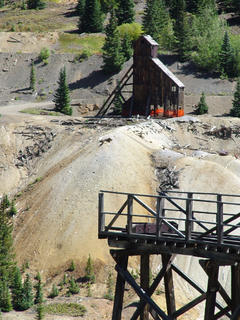 the tubs. In fact, Ouray is known for its hot springs. Many of the hotels have hot tubs, and there is a giant, public hot spring pool on the north side of town.
the tubs. In fact, Ouray is known for its hot springs. Many of the hotels have hot tubs, and there is a giant, public hot spring pool on the north side of town.We walk into town for dinner that evening. Ouray is an old Victorian town with beautiful, ornate houses and highly decorated town buildings. We eat dinner at the Bon Ton Restaurant in the basement of the St. Elmo Hotel. The side entrance of the hotel is reached by walking through a patio filled with tables topped with umbrellas, which are surrounded with plants and trees lit up with soft white lights.
We sat for a while in the elegant main parlor of the hotel until our table was ready, and then went downstairs to the beautiful red brick and timber restaurant. The food and drinks were superb. Mark was very impressed with the quality of the martinis!
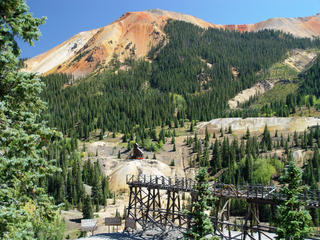 We relaxed in the hot tub again after dinner, with another deer and fawn grazing on the side of the hill above us. Ouray is a beautiful place, and we thoroughly enjoyed our stay here!
We relaxed in the hot tub again after dinner, with another deer and fawn grazing on the side of the hill above us. Ouray is a beautiful place, and we thoroughly enjoyed our stay here!Tomorrow we will drive down out of the mountains and head northwest into the desert again to Moab and Arches National Park!








